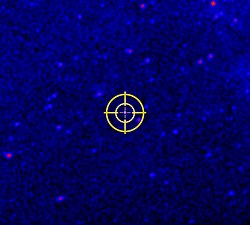PSR J0952–0607
| Observation data J2000.0
| ||
|---|---|---|
| Constellation | Sextans | |
| Right ascension | 09h 52m 08.319s[1] | |
| Declination | −06° 07′ 23.49″[1] | |
| Characteristics | ||
| Spectral type | Pulsar | |
| Apparent magnitude (i) | 22.0–24.4[2] | |
| Details | ||
| PSR J0952–0607 A | ||
dex | ||
Inclination (i) 59.8+2.0 | −1.9[4]° | |
| Semi-amplitude (K2) (secondary) | 376.1±5.1[4] km/s | |
| Other designations | ||
PSR J0952–0607, 4FGL J0952.1–0607 | ||
| Database references | ||
| SIMBAD | data | |
PSR J0952–0607 is a massive
PSR J0952–0607 was discovered by the
Discovery
PSR J0952–0607 was first identified as an unassociated
Distance and location
The distance of PSR J0952–0607 from Earth is highly uncertain.[2][3][4]
Binary system
The PSR J0952–0607
: 1Companion

The companion orbits the pulsar at a distance of 1.6 million km (1 million mi)
The companion was likely a former star that had been reduced to the size of a large gas giant planet or brown dwarf,[6][3]: 12 with a present-day mass of 0.032±0.002 M☉ or 34±2 MJ according to radial velocity measurements.[4]: 4 Due to intense irradiation and heating by the host pulsar, the companion's radius is bloated up to 80% of its Roche lobe[3]: 8 [4]: 4 and brightly glows with a thermal luminosity of about 10 L☉,[a] thereby accounting for much of the system's optical brightness.[4]: 1, 4 [2]: 1 As a result of bloating, the companion attains a low density likely around 10 g/cm3 (with significant uncertainty due to the system's unknown distance from Earth),[2]: 11 making it susceptible to tidal deformation by the pulsar.[3]: 12
The companion's pulsar-facing irradiated hemisphere is continuously heated up to a temperature of 6,200 K, whereas the companion's unirradiated hemisphere experiences a uniform[2]: 4 temperature of 3,000 K.[4]: 4 This hemispherical temperature difference corresponds to a difference in hemisphere luminosities, which in turn causes significant variability in apparent brightness as the companion rotates around the pulsar.[7]: 4 [3]: 8 This brightness variability is demonstrated in PSR J0952–0607's optical light curve, which exhibits an amplitude greater than one magnitude.[2]: 4
Mass
PSR J0952–0607 has a mass of 2.35±0.17 M☉, making it the most massive neutron star known as of 2022[update].[4] The pulsar likely acquired most of its mass by accreting up to 1 M☉ of lost material from its companion.[4]: 5
Rotation and age
PSR J0952–0607 rotates at a frequency of 707
Magnetic field
Measurements of PSR J0952–0607's spin-down rate show that the pulsar has a remarkably weak surface magnetic field strength of 6.1×107 gauss (6.1×103 T), placing it among the 10 weakest pulsar magnetic fields known as of 2022[update].[4]: 1 For context, ordinary pulsar magnetic fields usually lie on the order of teragauss (1×1012 G, 1.0×108 T), over 10,000 times greater than that of PSR J0952–0607.[13][4]: 1 Other millisecond pulsars exhibit similarly weak magnetic fields, hinting at a common albeit unknown mechanism in these types of systems;[3]: 2 possible explanations range from accreted matter burying the pulsar's surface magnetic field to heat-driven evolution of the pulsar's solid crust.[13]: 1–2 [4]: 1
Gamma-ray emissions
PSR J0952–0607 appears very faint in gamma-rays and was not detected in July 2011.[10][3]: 2
See also
- Tolman–Oppenheimer–Volkoff limit
- Black Widow Pulsar, the prototypical namesake for the class of binary pulsars with ablating companions
- PSR J1748−2446ad, the fastest-spinning pulsar located in the globular cluster Terzan 5
Notes
- ^ a b Luminosity converted from erg/s to L☉, given 3.81+0.46
−0.43×1034 erg/s from Romani et al. (2022)[4] and the solar luminosity L☉ = 3.826×1033 erg/s. - ^ Kepler's Third Law: given primary mass = 2.35 M☉ and orbital period = 6.42 h.light seconds (18787 km) from gamma-ray and radio pulsation timing.[3]: 6
References
- ^ a b "PSR J0952-0607 -- Pulsar". SIMBAD. Centre de données astronomiques de Strasbourg. Retrieved 26 July 2022.
- ^ . 108.
- ^ . 42.
- ^ . L18.
- ^ a b c d e Reddy, Francis (5 September 2017). "'Extreme' Telescopes Find the Second-fastest-spinning Pulsar". NASA. Retrieved 26 July 2022.
- ^ a b c Sanders, Robert (26 July 2022). "Heaviest neutron star to date is a 'black widow' eating its mate". Berkeley News. University of California Berkeley. Retrieved 26 July 2022.
- ^ . L20.
- ^ .
- . 128.
- ^ Bibcode:2019nova.pres.6048K. Retrieved 26 July 2022.
- . 33.
- ^ Starr, Michelle (24 September 2019). "Astronomers Detect Gamma Rays From an Extreme Pulsar Spinning 707 Times Per Second". ScienceAlert. Retrieved 27 July 2022.
- ^ hdl:1885/247814. 48.


![{\displaystyle a={\sqrt[{3}]{\frac {GMT^{2}}{4\pi ^{2}}}}}](https://wikimedia.org/api/rest_v1/media/math/render/svg/acc0794d19344d83b82ba93518c68a0fccd0b31b)



